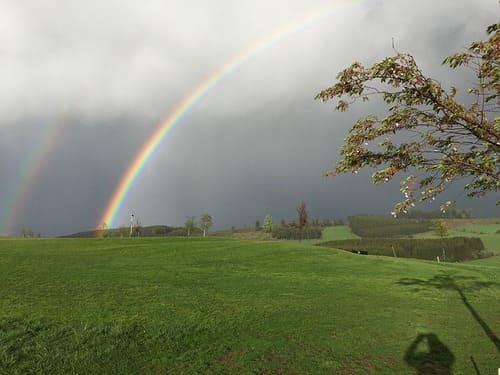Greetings, golf aficionados and eco-conscious swing maestros! Today, we’re diving into the watery depths of a question that’s as intriguing as a tricky dogleg left – How Much Water Does A Golf Course Use? So, lace up your golf shoes, grab your water-resistant scorecard, and let’s take a refreshing swing into the world where turf meets hydration!
Picture this: vast greens spread like emerald carpets, fairways glistening in the morning dew, and water hazards reflecting the azure sky like liquid gems. But behind this picturesque panorama lies a captivating mystery – just how many gallons are sipped by those thirsty fairways, and do golf courses have secret hydration rituals?
Whether you’re a golf course connoisseur marveling at the lush landscapes or an eco-warrior raising a putter in the name of water conservation. Join us as we tee off on a journey to demystify the water consumption enigma that swirls around golf courses like a perfectly executed bunker shot.
So, grab your favorite water bottle, adjust your wide-brimmed hat, and get ready for a blog post that quenches your curiosity while keeping a watchful eye on the water gauge. It’s time to discover the splashy secrets behind How Much Water Does A Golf Course Use!
The Importance of Water Conservation in Golf Courses
Golf courses are renowned for their lush green landscapes, impeccably maintained fairways, and pristine putting greens. However, these visually appealing features come at a cost, particularly in terms of water consumption. Water is an essential resource in the maintenance of golf courses, playing a vital role in preserving the health and aesthetics of the turf. Consequently, water conservation has emerged as a pressing concern for golf course managers and environmentalists alike.
Efforts to conserve water in golf courses are driven by several important factors. Firstly, the escalating global water crisis necessitates a more sustainable use of this precious resource. With growing demands for water from various sectors, including agriculture and domestic use, it is crucial that golf courses play their part in conserving water.
Furthermore, implementing effective water conservation measures can help minimize the ecological impact of golf courses. This reduces the strain on local water sources and preserving the surrounding environment. By reducing water usage, golf courses are also able to demonstrate their commitment to environmental sustainability and responsible land management.
Factors Affecting Water Usage in Golf Courses
Golf courses are known for their lush green fairways and well-maintained greens, but achieving such outstanding aesthetics requires a significant amount of water. Several factors contribute to the high water usage in golf courses, including turfgrass species, course design, and player expectations.
Firstly, the choice of turfgrass species greatly affects water usage. Some grasses, such as Bermuda and Zoysia, are more drought-tolerant compared to others, such as Bentgrass or Kentucky Bluegrass. Golf course managers often select grass types based on the climate and water availability in their region. Additionally, the size and layout of the course also impact water consumption. Courses with numerous water hazards or large areas of turf require more irrigation to maintain their appearance.
Furthermore, player expectations and conditioning standards play a significant role in water usage. Golfers have come to expect pristine playing conditions, which often necessitate intensive watering. The belief that a well-watered course equates to high-quality play can lead to excessive water use. Golf course managers must strike a balance between meeting player expectations and implementing sustainable water management practices to conserve this precious resource.
Examining these factors provides insight into the challenges faced when trying to reduce water usage on golf courses. By considering the specific needs of the turfgrass, course design, and player expectations, golf course managers can develop sustainable strategies for efficient water management.
Understanding the Irrigation Systems in Golf Courses
Irrigation systems play a crucial role in maintaining the lush green fairways and well-manicured greens that are synonymous with golf courses. These systems ensure that the turf receives an adequate supply of water to support its growth and health. In most golf courses, there are two types of irrigation systems commonly used: overhead irrigation and subsurface irrigation.
Overhead irrigation, also known as sprinkler irrigation, involves the use of sprinkler heads strategically placed throughout the course. These sprinkler heads release water in a fine spray, simulating rainfall. The advantage of this system is its versatility. It can be adjusted to different areas of the course, such as fairways, roughs, and greens.
On the other hand, subsurface irrigation, as the name suggests, delivers water directly to the roots of the grass through underground pipes. This method offers more precision in water distribution and reduces evaporation losses. Additionally, subsurface irrigation is known to promote deeper root growth, making the turf more resilient to drought conditions.
Understanding the different irrigation systems used in golf courses is essential for efficient water management. Determining the appropriate system for a particular area of the course, considering factors such as soil type, grass species, and local climate, is crucial. It is also imperative to monitor and maintain these systems regularly to ensure their optimum performance.
By incorporating smart irrigation technology and practicing proper water scheduling, golf courses can address water usage effectively. While also maintaining the quality of the playing surface.

The Role of Weather Conditions in Water Consumption
Weather conditions play a significant role in determining the water consumption in golf courses. Variables such as temperature, humidity, wind speed, and precipitation levels all contribute to the amount of water needed for irrigation. For instance, during hot and dry weather, golf courses require more water to compensate for the increased evaporation rates.
Similarly, low humidity levels accelerate moisture loss from the soil surface, intensifying the demand for irrigation. On the other hand, rainy periods can reduce the need for artificial irrigation as the natural precipitation helps to replenish soil moisture levels. Moreover, wind also influences water consumption by accelerating evaporation rates and drying out the turf, leading to increased irrigation needs.
Maintaining an awareness of weather conditions is essential for golf course managers and superintendents to optimize water usage. By closely monitoring weather forecasts and considering historical weather patterns, they can make informed decisions on irrigation scheduling and adjust water application accordingly. This proactive approach allows them to avoid overwatering during periods of precipitation or high humidity. While also ensuring sufficient irrigation during dry spells.
Additionally, understanding the local microclimate and its impact on the golf course can aid in adapting water management strategies to specific weather conditions. This ultimately promotes sustainable water usage and preserving the health and quality of the course.
Strategies for Efficient Water Management in Golf Courses
Strategies for Efficient Water Management in Golf Courses are crucial in ensuring the sustainability of these green landscapes. Golf courses require a significant amount of water to maintain their lush appearance and playable conditions. However, with the growing concerns over water scarcity and environmental impact, it is essential for golf course managers to adopt effective water management strategies.
One key strategy is the use of smart irrigation systems that incorporate sensors and data analysis. These systems monitor soil moisture levels, weather conditions, and plant water requirements to optimize water usage. By delivering water only when and where it is needed, these systems help to prevent overwatering, reduce water waste, and maintain healthier turf.
Additionally, implementing drought-tolerant grass species and native vegetation can be an effective strategy to reduce water consumption. These plants have adapted to local conditions and can thrive with minimal water, thus reducing the need for excessive irrigation. Furthermore, regularly monitoring and fixing leaks in the irrigation system can significantly limit water loss. This ensures that every drop is used efficiently.
Innovations in Irrigation Technology for Golf Courses
Water conservation in golf courses has become a priority in the industry, leading to the development of innovative irrigation technology. One such advancement is the use of smart controllers. These controllers rely on weather sensors and data analysis to optimize irrigation schedules. By considering real-time weather conditions, evapotranspiration rates, and soil moisture levels, smart controllers can adapt watering patterns to minimize water waste. This technology not only saves water but also ensures that the turf receives the appropriate amount of hydration for optimal health and playability.
Another innovation in irrigation technology for golf courses is the use of precision nozzles. Traditional irrigation systems often suffer from inefficient spray patterns that result in overspray, evaporation, and uneven water distribution.
However, precision nozzles address these issues by delivering water more precisely and uniformly. These nozzles use advanced engineering and design to achieve a consistent and controlled water flow. Which reduces water runoff and improving water retention in the soil. Ultimately, precision nozzles contribute to improved water management practices on golf courses. This minimizes water waste while maintaining the quality of the playing surface.
The Impact of Water Usage on Golf Course Maintenance Costs
One of the key factors that significantly impact the maintenance costs of golf courses is the usage of water. Water is an essential component in keeping the course in pristine condition, but its excessive usage can result in substantial financial implications. The cost of water itself, along with the cost of energy required for pumping and treating water, is a significant contributor to the overall maintenance expenses.
In addition, the more water a golf course requires, the higher the labor costs associated with maintaining irrigation systems and ensuring proper water distribution throughout the course.
Furthermore, excessive water usage can lead to the need for additional maintenance. Such as repairing damaged turf, fixing erosion problems, and addressing water-related issues that may arise due to overwatering. All of these factors combined can put immense pressure on the budget allocated for golf course maintenance.
To mitigate the impact of water usage on maintenance costs, golf course managers are increasingly adopting water conservation strategies. Implementing efficient irrigation systems that use precise targeting to deliver water only where and when it is needed is one approach to minimize water waste. Employing advanced technologies such as soil moisture sensors, weather-based controllers, and computerized irrigation systems enables golf course managers to optimize water usage based on actual needs and weather conditions.
Moreover, by regularly monitoring and analyzing water consumption, golf course management can identify areas of excessive water usage. This allows them to take corrective measures to reduce waste. These proactive initiatives not only help in conserving water but also yield significant cost savings in terms of reduced water bills, energy consumption, and labor required for maintenance activities.

Comparing Water Usage between Traditional and Modern Golf Courses
Water usage in golf courses can vary significantly between traditional and modern courses. Traditional golf courses typically use more water due to their larger size and outdated irrigation systems. These courses often have sprawling fairways and large greens that require frequent watering to maintain their lush appearance. Additionally, traditional courses often rely on manual labor for irrigation, which can lead to inefficient water distribution and overwatering in certain areas.
On the other hand, modern golf courses have made significant advancements in water conservation practices. These courses are designed with the environment in mind and incorporate innovative irrigation systems that optimize water usage.
For example, many modern courses use state-of-the-art computerized irrigation systems that monitor soil moisture levels and adjust watering accordingly. This ensures that water is applied only where and when it is needed, reducing waste and promoting water conservation. Moreover, modern courses often employ drought-tolerant grasses and native plants, which require less water to thrive.
Overall, the shift towards modern golf course design and management practices has resulted in a more efficient use of water resources. By embracing innovative technologies and incorporating sustainable landscaping strategies, modern courses are able to significantly decrease their water consumption while still providing golfers with a high-quality playing surface. It is important for golf courses to continue adopting these water-saving measures to minimize their environmental impact and contribute to the conservation of this valuable resource.
Case Studies: Successful Water Conservation Initiatives in Golf Courses
The implementation of successful water conservation initiatives in golf courses has become increasingly prevalent in recent years. One such case study is the Pine Ridge Golf Club, located in a region with limited water resources. To address this challenge, the club adopted a comprehensive water management plan that included the installation of high-efficiency irrigation systems, water-saving turf varieties, and the use of recycled water for non-playing areas. As a result, the club achieved a remarkable reduction in water consumption by 30% while maintaining the quality of the playing surfaces.
Another notable case study is the Desert Dunes Golf Resort, situated in a coastal area prone to drought conditions. Recognizing the need for sustainable water management, the resort implemented a reclamation system that collected and treated stormwater runoff from the surrounding areas. This treated water was then utilized for irrigation purposes, significantly reducing the resort’s reliance on freshwater sources. The resort also implemented measures to optimize irrigation practices, such as adjusting sprinklers to minimize overspray and using moisture sensors to ensure precise watering. As a result, the Sand Dunes Golf Resort achieved a considerable reduction in water usage by 40% without compromising the overall playing experience for golfers.
Future Trends in Water Conservation for Golf Courses
As golf courses continue to face the challenge of conserving water, several future trends are emerging in the industry. One of these trends is the advancement in smart irrigation systems. These systems utilize cutting-edge technology to monitor soil moisture levels, weather conditions, and real-time weather data to optimize water usage. By integrating these smart irrigation systems into golf courses, course managers can ensure that water is used efficiently and only when necessary, leading to significant water savings and reduced environmental impact.
Another future trend in water conservation for golf courses is the adoption of alternative water sources. With increasing water scarcity, golf courses are exploring innovative ways to reduce their reliance on traditional water sources. Some courses are now utilizing recycled or reclaimed water for irrigation purposes, which not only helps conserve freshwater resources but also reduces the overall demand for water.
Additionally, more golf courses are looking into rainwater harvesting systems, which collect and store rainwater for later use in irrigation. These alternative water sources not only contribute to water sustainability but also provide economic benefits by reducing water costs for golf course maintenance.
The future trends in water conservation for golf courses revolve around leveraging technology and exploring alternative water sources. As these trends continue to evolve and gain momentum, golf courses can lead the way in implementing sustainable practices and minimizing their environmental impact. By embracing these future trends, golf courses can contribute significantly to the conservation of water resources while still providing enjoyable and well-maintained playing conditions for golfers.

FAQs
Why is water conservation important in golf courses?
Water conservation is crucial in golf courses to reduce water consumption, lower costs, and minimize the environmental impact of managing a golf course.
What are some factors that affect water usage in golf courses?
Factors such as weather conditions, turfgrass type, irrigation system efficiency, course design, and maintenance practices can all influence the amount of water used in golf courses.
How do irrigation systems in golf courses work?
Golf course irrigation systems typically consist of a network of pipes, sprinkler heads, and controllers. These systems deliver water to the turfgrass at regular intervals to maintain optimal moisture levels.
How do weather conditions affect water consumption in golf courses?
Weather conditions, such as rainfall, temperature, wind, and humidity, impact the irrigation needs of golf courses. By monitoring and adjusting irrigation schedules based on weather forecasts, water usage can be optimized.
What are some strategies for efficient water management in golf courses?
Strategies for efficient water management include implementing smart irrigation technologies, using drought-tolerant turfgrass species, employing soil moisture sensors, practicing proper maintenance techniques, and educating staff and golfers about water conservation.
What innovations in irrigation technology are being used in golf courses?
Innovations such as soil moisture sensors, weather-based controllers, precision nozzles, and central control systems are being used in golf courses to improve irrigation efficiency and reduce water waste.
How does water usage impact golf course maintenance costs?
High water usage can significantly contribute to maintenance costs in golf courses. By implementing water conservation measures, courses can reduce water expenses and allocate resources to other areas of maintenance.
How does water usage differ between traditional and modern golf courses?
Traditional golf courses often have higher water usage due to design features, such as large turf areas and inefficient irrigation systems. Modern courses integrate water-saving practices, such as native landscaping and advanced irrigation technologies, to minimize water consumption.
Can you provide examples of successful water conservation initiatives in golf courses?
Yes, case studies showcasing successful water conservation initiatives are included in the article. These examples highlight the implementation of sustainable practices, technologies, and management strategies to reduce water usage while maintaining course quality.
What are the future trends in water conservation for golf courses?
The article discusses future trends in water conservation for golf courses, which may include the adoption of drone technology for irrigation management, the use of recycled water, the integration of artificial intelligence in irrigation systems, and increased focus on sustainable landscaping practices.






